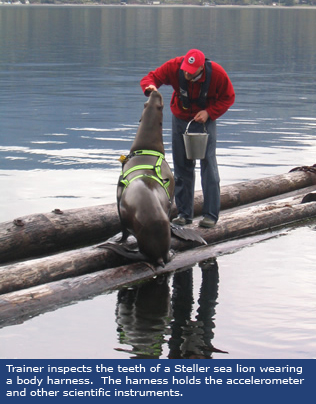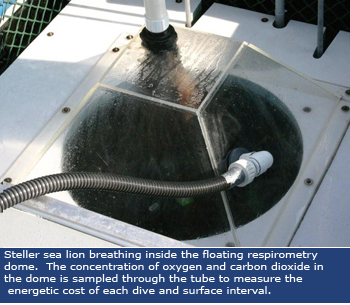
Scientists Measure Underwater Acceleration in Three Dimensions
As part of the ongoing effort to conserve dwindling Steller sea lion populations in the North Pacific Ocean, scientists are working to better understand how much food sea lions require and how they behave when foraging underwater for food. A key element of this research is finding a way to calculate how much energy a diving sea lion expends.
Naturally, this information is difficult to obtain from wild Steller sea lions diving in the ocean. However, a recent study using trained Steller sea lions diving in a controlled open water environment suggests a novel way to estimate the energetic cost of foraging.
The study, authored by Andreas Fahlman (UBC Marine Mammal Research Unit); Rory Wilson (University of Wales Swansea); and UBC’s Caroline Svärd, David Rosen and Andrew Trites, was recently published in the journal Aquatic Biology.
Measuring Activity
Previous studies have attempted to estimate the energetic cost of foraging by measuring heart rate or dive duration, both of which have produced imperfect results. By measuring activity, or movement at depth, the researchers sought a less invasive way to assess metabolism than traditional methods, such as surgically implanted heart rate monitors.
“Three Steller sea lions were trained to participate in free-swimming, open-ocean experiments designed to determine if activity can be used to estimate the energetic cost of finding prey at depth,” the authors write.
The three female sea lions were trained to voluntarily dive to fixed targets at depths of 10-50 metres (32-164 feet), and to resurface inside a floating dome. Devices in the dome measured the amount of carbon dioxide in the lungs after the dive, providing a measurement of energy expenditure via gas exchange. Attached to each sea lion was a harness containing an accelerometer that measured the direction and acceleration of all underwater movements.

The researchers compared the measurements obtained from the dome against those from the accelerometer, in an attempt to determine whether activity could be as effective as gas exchange in estimating metabolism (energy used). Finally, they sought to derive an equation to predict the metabolic rate (energy spent) over a complete dive event (the dive + the interval at the surface), to varying depths.
Positive Results
The team used the acceleration data to calculate the overall dynamic body acceleration (ODBA), a proxy for activity. They found that ODBA correlated well with the diving metabolic rate calculated from the dome’s gas exchange data. The results also corresponded with similar studies that used heart rate to estimate metabolic rate.
Overall, the study successfully showed that collecting acceleration data in three dimensions – a simple, non-invasive technique – can accurately estimate the field metabolic rate of wild Steller sea lions and other diving mammals and birds. By collecting additional data, the researchers hope to further refine their results, dividing the dive cycle into the cost of true diving and the cost of resting at the surface. This information is needed to refine estimates of how much food sea lions require in the wild.
![]() PUBLICATION
PUBLICATION
|

|

 |
||||||||||||
